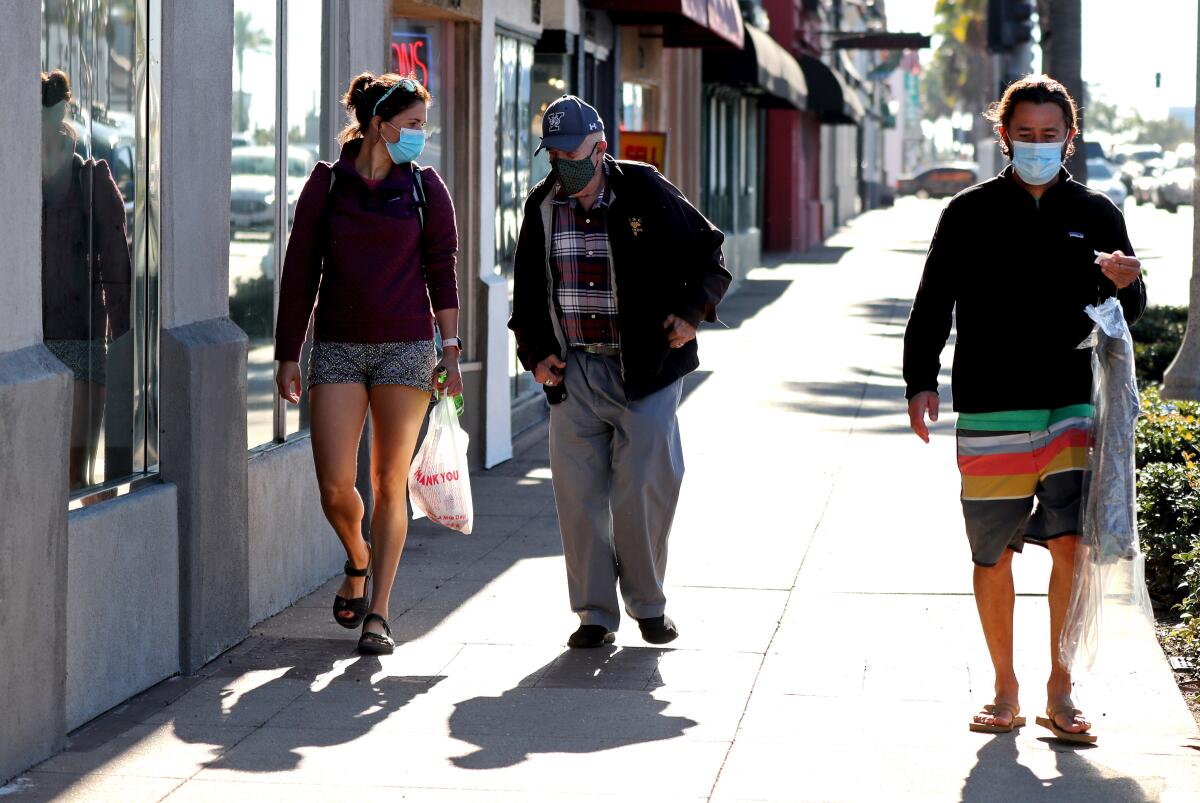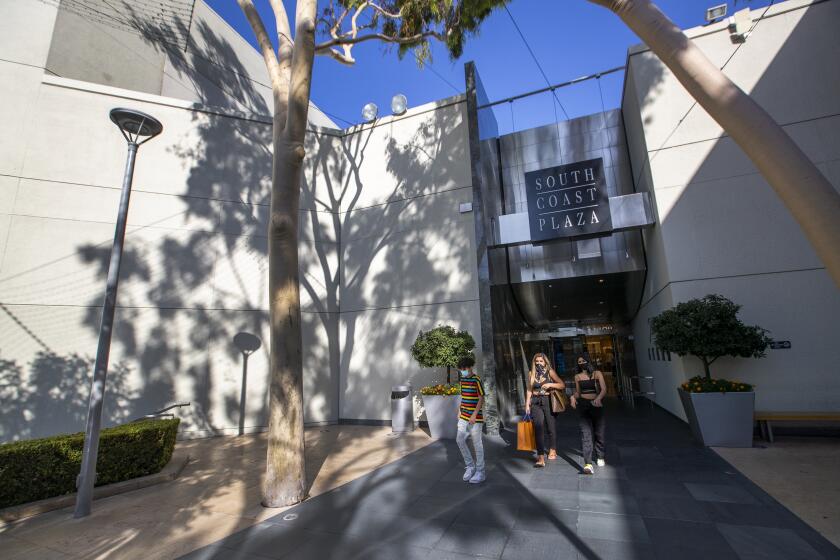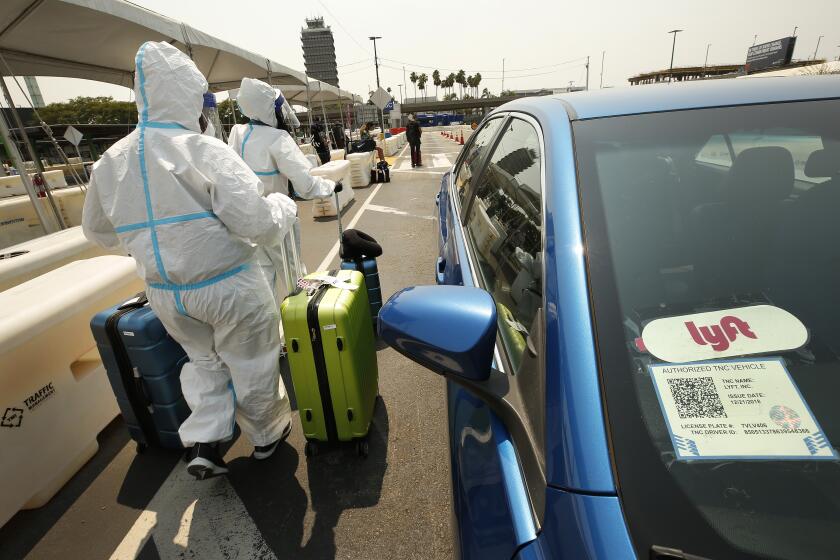Orange County moves back to ‘purple’ reopening tier as coronavirus surges

Citing a massive surge in new coronavirus cases across California, Gov. Gavin Newsom announced Monday nearly 40 counties will transition into more restrictive reopening tiers, including Orange County, which moves back to the widespread “purple” status effective immediately.
Newsom likened the move to pulling a statewide emergency brake as case rates climb and hospitals see increases in the number of COVID-19 patients in intensive care units.
“We are now moving backwards, not forward,” Newsom said. “Every age group, every demographic — racial and ethnic — in every part of the state we are seeing case rates increase. We are seeing community spread broadly now throughout the state.”
That trend bore out in Orange County Tuesday, where in the span of a few days the seven-day average of new cases per 100,000 residents skyrocketed from 5.6 to 10.8, according to the Orange County Health Care Agency.
All counties in Southern California are now in the purple tier, the most restrictive of the state’s reopening blueprint.
With more than 1.27 million tests issued so far, the county’s positivity rate stood at 4.6%. No new deaths were reported Tuesday, leaving the total number of fatalities at 1,526.
Orange County Board of Supervisors Vice Chairman Andrew Do said in a county news conference Tuesday while the move back to the purple tier and its consequent restrictions on area businesses was a decision made by the state, and not the county, officials would adhere to the mandates.
“The counties have little control over that,” Do said. “[But] in Orange County, we have to abide by the guidelines that are appropriate for the tier we have been assigned, and we’ll do our best to live within those guidelines.”
Do announced Tuesday that, in an initiative formed in partnership with 4th District Supervisor Doug Chaffee and Aliso Viejo-based Ambry Genetics, the county is securing some 500,000 COVID-19 saliva test kits that will be available free of charge at community clinics throughout Orange County in coming weeks.
The first 11,000 kits will be made available at clinics in Santa Ana and Anaheim, two cities hit especially hard by the virus.
Residents will soon be able to pick up a free kit, which includes a self-addressed FedEx envelope they can drop in the mail. If a kit is mailed by 1:30 p.m., Do said, it would arrive at a testing facility by noon the following day with results made available 24 hours later.
With the holidays approaching, county officials are urging residents to limit gatherings to members of two or three households at most. People are also encouraged to get tested for the virus two to three days before getting together, and again two to three days afterward.
“By making testing accessible and convenient, we would like you to work that into your holiday celebration practices,” Do said. “Widespread testing is necessary and important, and it is achievable. It’s not difficult to do, and we really encourage you to take advantage of that.”
Meanwhile Tuesday, the number of Orange County COVID-19 hospitalizations climbed to 270, with 79 individuals in intensive care units countywide. Health officials reported “limited” hospital capacity, with just 32% of Orange County’s total ICU beds being available for new patients.
The morning of the news conference, California Public Health Department officials reported 9,890 new cases, just three days after the state became the second in the nation, after Texas, to reach 1 million total infections. Only about 28% of the state’s total 7,662 ICU beds were open as of Monday.
“This significant change in transmission … statewide is absolutely essential for us to immediately take control of and manage so that we get out of this difficult period,” California Health and Human Services Secretary Mark Ghaly said Monday. “Tracking the data over many, many months shows us that cases today will end up in our hospital beds in two to three weeks consistently at a rate of about 12%.”
Orange County is one of 28 across the state to be moved from the red “substantial” tier back to the “widespread” purple tier, where a total of 41 counties comprising more than 94% of California’s population will remain for the unforeseeable future.
State guidelines indicate many nonessential businesses will be forced back outdoors, after being allowed under the red “substantial” tier to provide limited indoor services with precautions in place.
Airports, train stations and rest stops are places where people are at risk of being exposed to the virus, and it can be difficult to stay six feet away from others, as health experts strongly recommend.
As such, Orange County indoor retail traffic will have to be reduced from 50% capacity to 25% capacity following Monday’s announcement, while restaurants, movie theaters, fitness centers, museums and zoos will be forced to move 100% of their operations outdoors.
Here are the latest cumulative coronavirus case counts and COVID-19 deaths for select cities in Orange County:
- Santa Ana: 12,547 cases; 322 deaths
- Anaheim: 11,265 cases; 330 deaths
- Huntington Beach: 2,899 cases; 86 deaths
- Costa Mesa: 2,249 cases; 45 deaths
- Irvine: 2,213 cases; 14 deaths
- Newport Beach: 1,352 cases; 26 deaths
- Fountain Valley: 672 cases; 21 deaths
- Laguna Beach: 276 cases; fewer than five deaths
Here are the case counts by age group, followed by deaths:
- 0 to 17: 5,071 cases; one death
- 18 to 24: 9,815 cases; four deaths
- 25 to 34: 14,142 cases; 21 deaths
- 35 to 44: 10,500 cases; 40 deaths
- 45 to 54: 10,616 cases; 119 deaths
- 55 to 64: 7,934 cases; 211 deaths
- 65 to 74: 4,016 cases; 302 deaths
- 75 to 84: 2,156 cases; 331 deaths
- 85 and older: 1,659 cases; 497 deaths
Updated figures are posted daily at occovid19.ochealthinfo.com/coronavirus-in-oc. For information on getting tested, visit occovid19.ochealthinfo.com/covid-19-testing.
All the latest on Orange County from Orange County.
Get our free TimesOC newsletter.
You may occasionally receive promotional content from the Daily Pilot.






